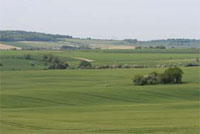Fields in the Landscape
 From patchworks of ancient field systems to bold strip lynchets which form striking features on the sides of chalk escarpments in low winter light. The pattern of enclosure in the AONB is a key feature of its distinctive character. The downland areas are characterised by very large fields which contrasts greatly with the smaller more irregular and sinuous fields in the Vale of Wardour and in the chalk valleys.
From patchworks of ancient field systems to bold strip lynchets which form striking features on the sides of chalk escarpments in low winter light. The pattern of enclosure in the AONB is a key feature of its distinctive character. The downland areas are characterised by very large fields which contrasts greatly with the smaller more irregular and sinuous fields in the Vale of Wardour and in the chalk valleys.
There are ancient field systems covering large areas, especially on former downland, dating from the Bronze Age onwards. These are often undated and over lie each other. Many are under the plough but there are surviving pristine examples, such as at Pertwood. Prehistoric fields systems surround Prehistoric settlements, for example, Iron Age earthworks on the West Wiltshire Downs.
Evidence for the Medieval period is characterising by striking Medieval lynchets which are prominent on chalk escarpments, for example, to the north of Mere and there are less visible, but more extensive, fossilised Medieval strip fields in the vicinity of Martin and in the Gussage Valley.
Evidence for later fields is represented by small pre 1800 regular and irregular fields which occur across the AONB some of these are locally distinctive such as the irregular curving fields in the vicinity of the Donheads. These are often hedged and associated with copses.
Another important feature are the relic water meadow systems in the bottom of the chalk valleys
20th century large open fields dominate downland areas; these are much larger in size and scale than on the Dorset Downs to the west. They are often associated with fences and less mature hedgerows and in some cases have been created through the removal of earlier boundaries.
More information on the historic fields of the AONB can be accessed by clicking here: Theme 3: Fields in the Landscape.
This document forms part of the wider AONB Historic Environment Action Plans.
